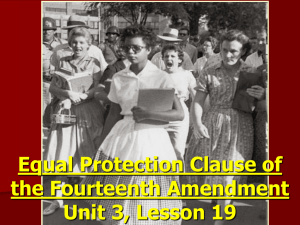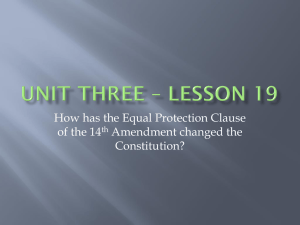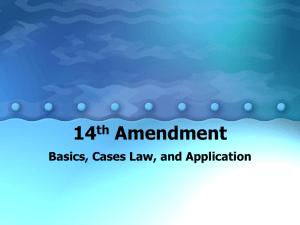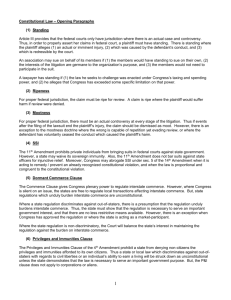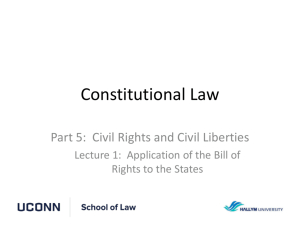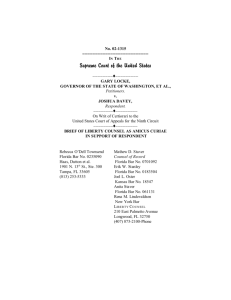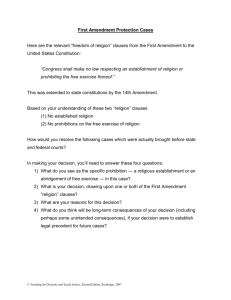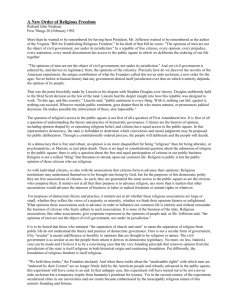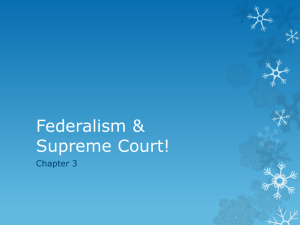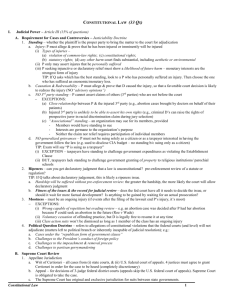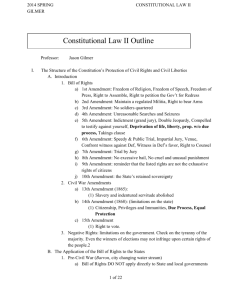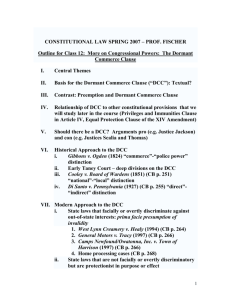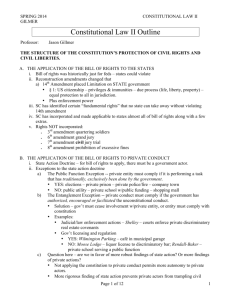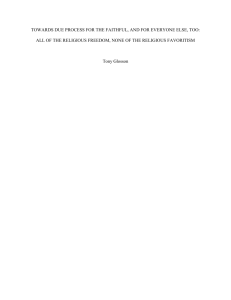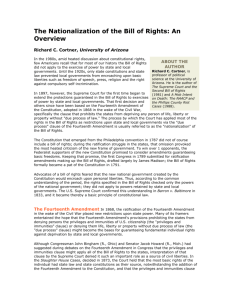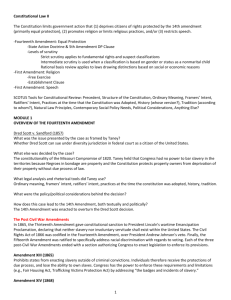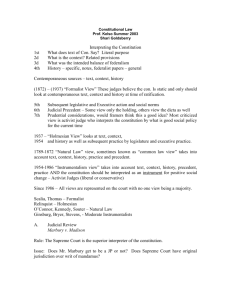UNIT IV
advertisement
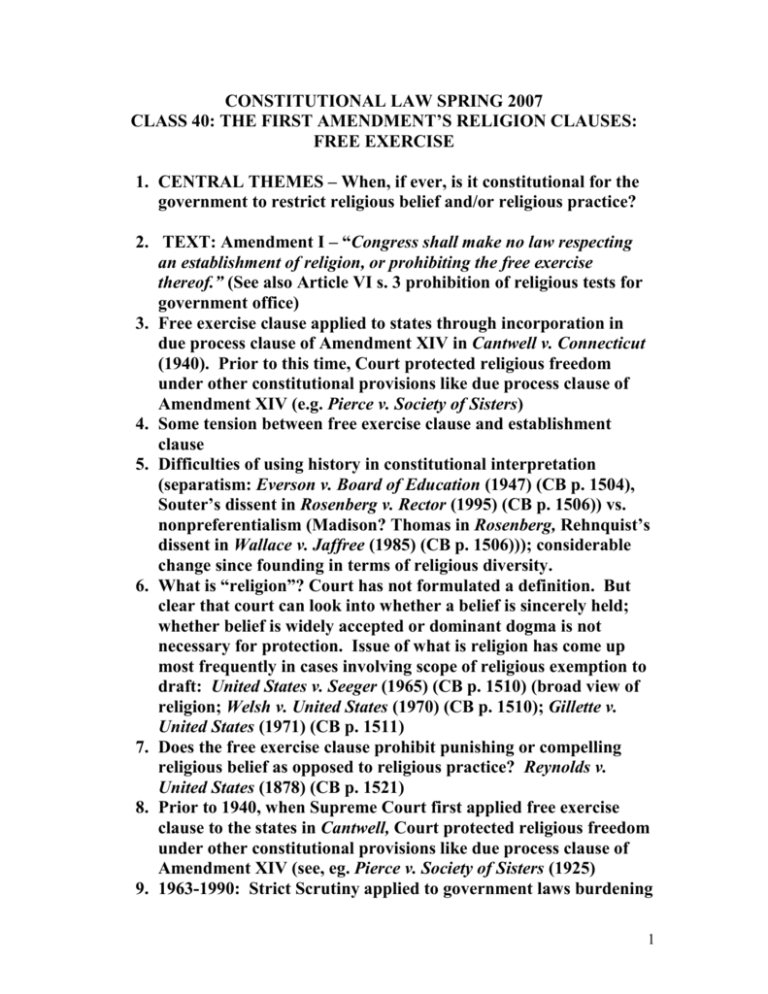
CONSTITUTIONAL LAW SPRING 2007 CLASS 40: THE FIRST AMENDMENT’S RELIGION CLAUSES: FREE EXERCISE 1. CENTRAL THEMES – When, if ever, is it constitutional for the government to restrict religious belief and/or religious practice? 2. TEXT: Amendment I – “Congress shall make no law respecting an establishment of religion, or prohibiting the free exercise thereof.” (See also Article VI s. 3 prohibition of religious tests for government office) 3. Free exercise clause applied to states through incorporation in due process clause of Amendment XIV in Cantwell v. Connecticut (1940). Prior to this time, Court protected religious freedom under other constitutional provisions like due process clause of Amendment XIV (e.g. Pierce v. Society of Sisters) 4. Some tension between free exercise clause and establishment clause 5. Difficulties of using history in constitutional interpretation (separatism: Everson v. Board of Education (1947) (CB p. 1504), Souter’s dissent in Rosenberg v. Rector (1995) (CB p. 1506)) vs. nonpreferentialism (Madison? Thomas in Rosenberg, Rehnquist’s dissent in Wallace v. Jaffree (1985) (CB p. 1506))); considerable change since founding in terms of religious diversity. 6. What is “religion”? Court has not formulated a definition. But clear that court can look into whether a belief is sincerely held; whether belief is widely accepted or dominant dogma is not necessary for protection. Issue of what is religion has come up most frequently in cases involving scope of religious exemption to draft: United States v. Seeger (1965) (CB p. 1510) (broad view of religion; Welsh v. United States (1970) (CB p. 1510); Gillette v. United States (1971) (CB p. 1511) 7. Does the free exercise clause prohibit punishing or compelling religious belief as opposed to religious practice? Reynolds v. United States (1878) (CB p. 1521) 8. Prior to 1940, when Supreme Court first applied free exercise clause to the states in Cantwell, Court protected religious freedom under other constitutional provisions like due process clause of Amendment XIV (see, eg. Pierce v. Society of Sisters (1925) 9. 1963-1990: Strict Scrutiny applied to government laws burdening 1 religious freedom (at least in theory): Sherbert v. Verner (1963) (CB p. 1523). During this time, however, Court only upheld free exercise challenges in two areas: i. denials of unemployment benefits like Sherbert, e.g. Thomas v. Review Board (1981) (CB p. 1526), Hobbie v. Unemployment Appeals Comm’n (1987) (CB p. 1526), Frazee v. Illinois Employment Security Department (1989) (CB p. 1526) ii. compulsory school law applied to Amish high school aged children : Wisconsin v. Yoder (1972) (CB p. 1526) Some examples of denials of free exercise claims from 1963-1990 (using 3 techniques – finding overriding government interest in uniform regulation, finding that free exercise interests were attenuated and government interests paramount in certain environments like the military; rejecting free exercise claims seeking to alter “internal” government operations i. United States v. Lee (1982) (CB p. 1528) ii. Bob Jones University v. United States (1983) (CB p. 1529) iii. Goldman v. Weinberger (1986) (CB p. 1529) iv. Bowen v. Roy (1986) (CB p. 1531) v. Lyng v. Northwest American Cemetary Protective Ass’n (1988) (CB p. 1532) 10.1990: A big change in the law of free exercise: Employment Division Dept. of Human Resources v. Smith (1990) (CB p. 1533), Church of Lukumi Babalu Aye v. Hialeah (1993) (CB p. 1514) – now a NEUTRAL LAW OF GENERAL APPLICABILITY will not violate the free exercise clause unless it fails RATIONAL BASIS scrutiny; but a LAW THAT IS NOT NEUTRAL OR OF GENERAL APPLICABILITY will be found unconstitutional unless it meets STRICT SCRUTINY. 11.An attempt to negate the Smith test: THE RELIGIOUS FREEDOM RESTORATION ACT of 1993: City of Boerne v. Flores (1997) (CB p. 1541) – what is the constitutional status of the RFRA as applied to (i) state governments (ii) local governments (iii) federal government?; Gonzalez v. O Centro Espirita Beneficiente Uniao do Vegetal (2006) (Supp. p. 52) 12.Religious Land Use and Institutionalized Persons Act of 2000: government must meet strict scrutiny if it significantly burdens religion in land use decisions and to regulate institutionalized 2 persons 3
